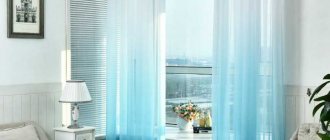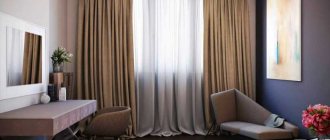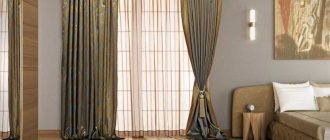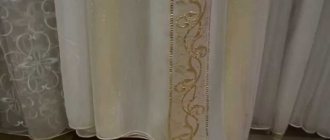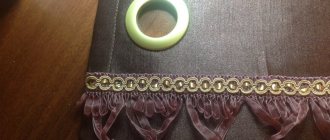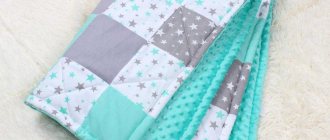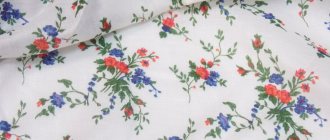Choice
The choice of curtains must be approached responsibly. At first glance, it seems that the tulles are all similar, and it doesn’t really matter which one to choose. Photos of tulle in the interior, which can be seen on the Internet, do not convey all the features of the fabric and pattern.
In fact, all tulles are made of different quality, from different materials; their choice largely depends on the interior of the room and the taste preferences of the buyer.
Please pay attention to some nuances:
- For dark and colorful curtains, it is better to choose light tulle without patterns;
- A window with an adjacent balcony door can be decorated with asymmetrical tulle;
- Bright tulle will be an appropriate accent in a room where there are many elements of brown, gray or beige.
An interior without tulle looks empty and flat. Don't neglect this element of room decoration.
How to choose tulle
- Voile is a thin, airy, perfectly draping fabric made from synthetic or natural fibers.
- Organza is a denser fabric, less breathable and difficult to fit into folds. At the same time, organza has significant advantages - strength and durability, affordable cost, special shine and structure of the fabric.
- Lace is an openwork fabric, popular in retro, Provence, and shabby chic styles.
- Mesh is a fabric with honeycombs. Suitable for many interiors, but accumulates dust.
- Muslin is a wear-resistant eco-friendly fabric, soft and pleasant to the touch, drapes well, and does not fade in the sun. Thanks to its natural appearance and predominant pastel shades, it suits both modern interiors and rustic style. The disadvantages are the cost and the need for careful care.
- Kisey (rain) interspersed with compacted threads or beads.
In terms of style, tulle curtains can be either minimalist (straight, Japanese panels) or with textured folds (London, Austrian, French awning), as well as with flounces along the entire length, sides or bottom edge.
How to choose new tulle
Tulle is chosen taking into account the tasks assigned to it. It is believed that textiles should diffuse light, hide the room from prying eyes and give the window a complete look. Tulle does not have to perform all functions at the same time. For example, on the upper floors, residents may not worry about privacy, so in such rooms canvases are placed for beauty and partial darkness.
Ideally, all details are selected at the project stage: finishing is selected, furniture placement is planned, type of decor, type of fittings. But this is not always possible to do. More often we buy or order curtains for ready-made renovations. If you are thinking about which tulle is better to choose, then a universal option is a white straight curtain without a pattern. There is a place for such canvases in almost any design, and this is an ideal option if you rent an apartment and move often. The fabric should resonate with the textile design of the room: if the design contains a lot of natural materials, it is better to support this idea with the texture of tulle.
Transparent, almost invisible tulle is suitable for decorating a window with an interesting design (unusual geometry, with a creative frame) and excellent landscapes. If a standard design is not your option, but you don’t want to hide a beautiful window or panoramic view, you can choose tulle with a pattern, placing it according to the curtain principle: on the sides of the window opening, obliquely or overlapping. If it is necessary to maintain easy access to the window sill, short tulle is used or the fabric is gathered in horizontal decorative folds.
Think in advance whether you are ready to devote time to delicate washing, steaming and additional care of the fabric. If less worry is your option, choose synthetic or mixed materials that are easier to use. Remember that curtains collect dust and need to be cleaned several times a year, so the crystal whiteness of the fabric may not last long, and bright shades may fade. When choosing fabrics, pay attention to color fastness and washing conditions.
How to choose tulle color
Materials
Most often, tulle is sewn from light, thin fabrics that allow air and color to pass through. It can be organza, mesh, muslin or veil.
Organza is a durable material that is made by twisting several threads. This canvas is not afraid of dust. Organza can be made from silk or synthetic fabrics.
Veil is a universal material that is soft and tender. It is less transparent. The veil is made from silk, cotton, polyester or wool.
Kisey is a light cotton fabric. It is transparent, has a perforated structure, consists of individual threads, and is a mesh. This fabric has to be washed more often, as dust particles accumulate in it, but it can be washed in a washing machine. The fabric allows sunlight and fresh air to pass through.
Types and features of fabrics for tulle
Tulle can be matte and transparent, woven from thin threads and mesh, it can be embroidered or decorated with lace. When choosing tulle for your windows, first of all, let’s look at what kind of fabric is most often used to sew it.
If we talk about what fabrics are used for sewing tulle, most often it is:
- Organza is a fabric made of polyester or silk threads, smooth and transparent, with a strong thread, airy and weightless. Organza does not allow air to pass through, although it easily allows sunlight to pass through, does not accumulate dust and dries quickly, so it is perfect for allergy sufferers.
- Mesh is a fabric also often used for sewing tulle and is characterized by a mesh structure. It perfectly transmits air and light, is easy to wash - it can be used as an independent decorative element or combined with curtains. It is susceptible to dust and therefore should not be hung in a room where allergy sufferers live.
- The veil is translucent and thin, made of silk or wool or cotton threads. Marked by long service life and perfectly transmits air flows and light, does not accumulate dust.
- Kisey is a light and airy fabric made from silk or cotton threads, linen fibers, although today synthetic materials are increasingly used.
- Muslin - with its help you can create a special style in the room. Muslin is distinguished by a special type of thread weaving, does not allow air to pass through, is easy to care for, and does not fade in the sun.
Weaving types
According to the type of weaving, they are distinguished:
Note!
- Curtains for windows - TOP 120 photo and video examples. Styles and shapes of curtains, their differences. Advantages and disadvantages of window curtains
DIY curtains - instructions for sewing curtains with your own hands. Types of fabrics, colors and patterns for curtains. 120 photos + video reviews
Photos of curtains: design of curtains of different sizes and lengths. Color range, types of materials, patterns and curtain fastenings (photo + video)
Batiste is a soft and smooth fabric. It consists of thin fibers that are tightly twisted. Patterns are often embroidered on it.
Jacquard is a durable fabric with a relief created by weaving threads of different thicknesses. Chiffon does not deform and is not difficult to care for. This type of weaving looks advantageous on windows that face north. It is better to combine it with plain curtains.
Chiffon is a textured fabric that is usually decorated with additional elements - bows, ribbons or flowers.
How to choose a beautiful tulle for thick curtains?
This translucent window covering fabric can be used either alone or in combination with a denser material. What options go well with tulle:
- Jacquard is a material with a woven pattern.
- Blackout - light-proof canvases available in a variety of colors. They can be plain or patterned, light or dark.
- Velvet is the same, with a fleecy surface.
- Satin and satin are fabrics with a glossy surface.
- Brocade is heavy, elegant, embroidered with gold and silver threads.
- Cotton and linen - used in eco and country style rooms.
Which tulle is better to choose taking into account thick curtains:
- When selecting a set, it is desirable that one of the fabrics matches the color of the wallpaper. The companion should match her in tone or be contrasting.
- Options that are made in the same color or differ by one or two tones look beautiful. One companion is plain, the second with a pattern that differs from the base in color or texture.
- Thick fabrics with a rough or fleecy surface look good with smooth organza.
At the stage of installing the cornice, care must be taken that the distance between the tulle curtain and the thick curtain is sufficient to form beautiful folds.
Colors
White tulle in the interior never loses its popularity. This is due to the fact that the translucent fabric is white:
- It seems light and airy. There is a feeling that the room is “breathing” and becomes fresher. This tulle makes the room visually wider;
- Combines with fabrics of any colors, with designs and patterns, with any style;
- Does not delay light, but only slightly diffuses it, making the lighting softer;
- Universal in many ways.
In the 21st century, white tulle is not the only option. Modern designers have found a lot of interesting variations in window design using tulle of different colors.
Pastel-colored tulle is combined with bright curtains; bright tulle can become an independent decorative element that creates an accent on the window.
Note!
- Organza tulle: advantages and disadvantages of the material. Varieties of tulle and fastenings. Tips for sewing and installation (photo + video)
- Tulle design - TOP 130 photos + video reviews of tulle designs. Features of choosing fabric, length, quantity and type of tulle
Gray tulle: nuances of using gray tulle in the interior. Suitable gray fabric materials. 150 photos + video examples
Cream, beige or sand tulle can easily fit into almost any interior. For those who like to bring the most daring ideas to life, tulle is made in golden and silver colors.
A children's room allows you to decorate the interior with peach, lavender, lemon or light green tulle.
Yellow tulle creates a win-win combination with blue and green curtains.
Basic Rules
As in any important matter, when selecting curtains you need to follow some principles. Following them will help you avoid common mistakes and purchase a truly high-quality product that will serve you for many years.
Three-layer curtains - classic sophistication
- Designers recommend choosing curtains to match the color of the furniture, not the wallpaper. This advice is due to the fact that, as a rule, people change wallpaper more often than furniture, so after renovation there is a need to buy new curtains.
Transparent chiffon curtains will add a touch of romance to the interior
- The texture of the fabric must match the patterns and ornaments applied to other interior elements. Here you should be extremely careful not to overdo it with the number of patterns in the room. Plain curtains are a universal option, as they will perfectly complement any style and will not look pretentious. If you still prefer products with a pattern, choose them very carefully, taking into account the design of furniture and carpets.
Curtains in rich plum and cherry tones look harmonious in a living room with pastel wallpaper
- Give preference to unusual designs. They will help transform the room and give it some zest. For example, tulle in a girl’s nursery can be decorated with bright tie-backs made in the shape of bows, butterflies or hearts. In turn, the curtains themselves can contain images of the baby’s favorite fairy-tale characters. We are sure that such a design solution will certainly delight the child and will contribute to creative development.
Bright large pattern in Provence style - a trend in recent years
- Curtains should be practical. In other words, when choosing a material, you should pay attention to ease of use and maintenance. Give preference to fabrics that have been treated with special dirt-repellent and fire-retardant compounds. In addition, the product must be washable by both hand and machine. For example, velvet curtains are difficult to clean at home, so you will have to go to a dry cleaner, which will entail additional costs. Recently, curtains containing natural and synthetic fibers have become increasingly popular, as they combine the advantages of both types: they are practical and have an excellent appearance. Before choosing tulle and curtains, ask your consultant what fabric they are made from, find out about its properties and care recommendations.
The overall pattern on the curtains and tulle will emphasize the unity of style
- Pay special attention to the selection of material density. Experts recommend that residents of the first floors pay attention to dense fabrics with lining. They will protect the room from the sun's rays and the annoying glances of passers-by. If the room is quite dark, it is better to install curtains made of translucent fabrics, which transmit light well and visually increase the space.
In dark rooms you can use openwork curtains - they allow sunlight to pass through well
- Consider the purpose of the room. This is perhaps one of the most important factors. In the bedroom, you should create an atmosphere of peace and security with the help of thick curtains, so that nothing can interfere with rest, and in the nursery, bright shades and colorful designs should prevail, developing the imagination of the baby. Short tulle will be the best choice for the kitchen, since long curtains take up too much space and get very dirty. In addition, due to the high risk of fire, they are prohibited from being placed near the stove.
Laconic curtains in light colors will visually increase the space
- In small rooms it is better to install compact structures. Luxurious curtains with lambrequins and many decorative elements are well suited for spacious bedrooms and living rooms. If placed in a small room, they will not only take up a lot of space, but also visually narrow the space. Give preference to laconic curtains, complementing them with neat tiebacks.
The emphasis on bright curtains with a simple geometric pattern is a profitable idea for a minimalist bedroom
- Before you go to the store, take all the necessary measurements. Please note that if there is a radiator or battery under the window opening, according to sanitary and hygienic standards, the curtain should not cover them. Otherwise, the fabric will prevent complete heat transfer, and it will take longer to warm up the room.
Tulle made of plain cream organza will add warmth and comfort to the room.
- When you need to visually expand the room, use curtains with a horizontal print, and strict vertical lines will help make low ceilings higher. Owners of spacious living rooms often find that large windows make the room seem uncomfortable. In the photo you can see how a beautiful tulle for the hall, complemented by lambrequins and luxurious drapery, makes the hall elegant and comfortable.
Exquisite drapery will help the hostess make the spacious living room more comfortable
- It is better to equip large window openings with two fabric panels. This will give you
Using curtains you can decorate not only windows, but also doorways
Now that we have looked at the basic rules for choosing curtains, you should familiarize yourself with the most popular types for each room.
Colorful and plain curtains
Plain curtains are chosen by people who want to achieve laconicism and tranquility in the interior. Tulle of the same color cannot spoil the interior, unless it is chosen completely without taking into account the color scheme of the room.
Multi-colored curtains look more original, but you need to choose them more carefully. The interior should be thoughtful and harmonious.
Note!
- Tulle on a ribbon: advantages and disadvantages of tulle on a ribbon. Types of curtain tapes. Tips for sewing and installation (photo + video)
- Small curtains: TOP-180 photos + video of design options for small curtains. Features of small curtains in the interior. Types of curtains, fabrics and colors
- Curtains for the hall: requirements for choosing curtains for the hall. Selecting the length, material and shade of fabric for curtains in the living room (photo + video)
Striped tulle in the interior looks appropriate if white vertical stripes are combined with pastel stripes of the same color. Sometimes bright, crazy solutions actually add color and style to the interior.
Patterns and designs on tulle should be repeated on other items. Then the room will resemble a fairy tale kingdom in which everything fits perfectly. Such a perfectionist's paradise can be created if you repeat the same pattern on decorative elements - on boxes and boxes, on a shelf, on a tablecloth or on a sofa.
The combination of several curtains in pastel shades looks very beautiful and elegant.
Tulle in the living room in a modern style - how to decorate a window
When creating the interior design of any room, window design is one of the main stages. The final stage is the choice of tulle fabric for the living room. The options for decorating windows with tulle are varied: you can combine fabrics by color, texture, using several canvases at once. Designers note the following trends:
- A combination of tulles of the same texture but different colors looks modern.
- An interesting option is to combine volumetric lace fabrics with smooth tulle.
- Ombre curtains look unusual, with smooth transitions of shades of the same color - from light to dark.
- The interior is exquisitely decorated with a combination of matte and glossy tulle of the same color, as well as tulle with discreet woven stripes.
- Curtains made of tulle fabrics look great in natural colors, which combine similar colors of different intensities. Favorites include a palette of shades of sand, gray, nut, discreet green and yellow, milky cream.
We also recommend: Curtains for a country kitchen - beautifully decorate the window
- A simple cut is used, but taking into account possible multi-layering.
Directions for decorating a living room with tulle in a modern style
- A double row of curtains of varying degrees of density looks interesting in the living room, for example, transparent and translucent, or plain tulle in combination with patterned tulle, or a combination of plain tulle in two or three colors.
- Modern manufacturers produce ready-made sets of companion curtains that look very impressive.
Using different shades of 2-3 layers of thin veil, we get an unusual window decor. And curtain tiebacks are indispensable helpers for creating beautiful draperies. With their help, you can style your curtains differently every day.
- Tulle hung over thick curtains looks unusual and beautiful - their shape is visually perceived as a cloud.
- Light tulle with an expressive texture, contrasting pattern or bright embroidery attracts the eye to the window.
- If one light curtain is enough in your living room, pay attention to tulle, in which the shades, like delicate watercolors, smoothly transition into one another, becoming more and more saturated. This option will decorate any window.
- If the living room has two windows on one wall, and there is a small partition between them, then it is better to hang a wide tulle curtain over the entire wall. This design option, combining two windows and a partition between them into a single composition, will look richer than curtains for each window separately.
- You can do without thick curtains. In this case, you can use two or three layers of tulle, each of which can be decorated differently. This design option will allow the window space to look weightless, while creating the necessary shading. A combination of different color shades will add color to the interior of the room.
- If you use blinds, roller blinds or Roman blinds in the living room, then light tulle curtains go perfectly with them, which add airiness to the window space and create additional decorativeness.
- The symbiosis of tulle curtains with Japanese panels made of thin or thick fabrics looks unique and elegant.
Tulle, which was in fashion 2-3 years ago, remains in demand in 2021. For each specific room, you can choose options for beautiful tulle in the living room. But remember: matching the tulle to the interior of the room is the main condition for window design. If everything is done correctly, then enjoy the result - a harmonious, holistic environment.
By the way, if you sew tulle curtains yourself, you can use the curtain cost calculator, which is on our website.
Room size
The more ruffles, lace, embroidery and other details that give volume to the tulle, the more spacious the room in which it will be placed should be. In small rooms it is better to hang light, plain fabrics.
Above the windows located on the south side, you can hang tulle with a large pattern. A dark color will provide better protection from direct sunlight.
On the north side, white or light tulle made of transparent fabric will look ideal.
Curtains for the living room
Tulle in the living room interior can be an accent or background. A plain, lightweight, pastel-colored fabric will decorate any living room, regardless of the style of the room.
The combination of bright curtains and delicate tulle creates comfort and harmony in the room. If you want to make the room more peaceful and relaxing, you need to choose tulle and curtains of the same color, but of different saturations.
Curtains for the bedroom
In the bedroom, plain and delicate tulle creates an atmosphere of peace and comfort. The use of bright tulle is not allowed. It will irritate the eye and interfere with proper rest.
Tulle with guipure inserts is a combination of modern design and classics.
When choosing curtains for the bedroom, try to combine the colors of the tulle, curtains and bedspreads.
